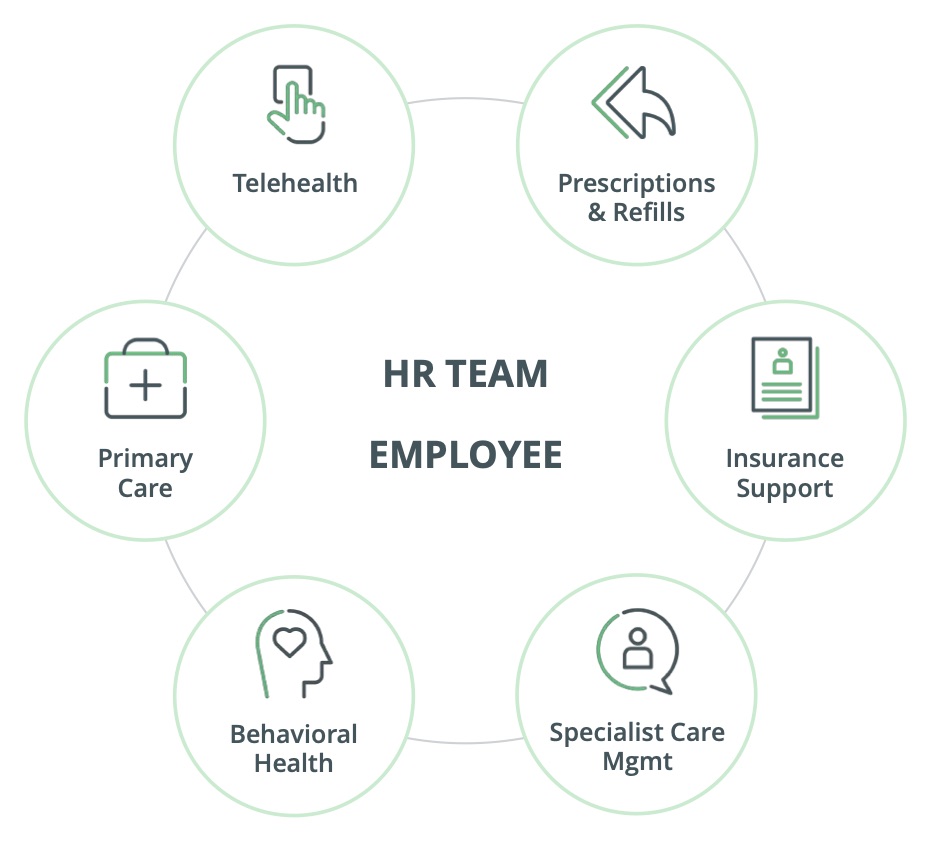Employees are your organization’s greatest asset, so ensuring their health and well-being is essential. Unfortunately, administrative back-office duties, manual processes, and insufficient tools and technologies prevent HR professionals from advancing key initiatives. As a result, HR has less time to help employees understand today’s complicated healthcare landscape.
So, how can HR manage to accomplish this when forced to navigate through a complex, fragmented healthcare system? In this blog, we will uncover the six major hurdles HR teams face and solutions to help them provide employees with an integrated, transformative healthcare experience.

Challenge #1: Spiraling costs
A survey by Kaiser Family Foundation found that roughly 153 million Americans rely on employer-sponsored coverage, but rising healthcare costs are pushing many workers to their limits. According to the 2019 KFF survey, the amount employers and workers pay toward premiums grows more quickly over time than workers’ wages and inflation. Since 2009, average family premiums have increased 54% and workers’ contributions have soared 71%, compared with wages (26%) and inflation (20%).
Solution: Educate employees and analyze trends
Employers can keep health costs under control by helping employees make better use of their healthcare resources.
Some solutions provide insurance navigation experts, individuals that can help maximize HR’s success with health plans during open enrollment and throughout the year. They work with HR departments to receive updated health plan benefit details month-to-month and year-to-year. Armed with this knowledge, they can explain to employees how their coverage may change during each open enrollment period.
Some solutions go even further by offering analysis on group activity patterns that indicate areas of concern. This can highlight ways to optimize your company’s health plans and increase employee engagement. For example, if employees are having trouble accessing a certain type of medical service or medical provider, or if there’s an increase in demand for employees seeking behavioral health services, employers can decide whether the company should adapt their health plan designs, provider networks, and complementary employee benefits to meet evolving employee needs.
Challenge #2: Growing complexity
With regulatory changes in constant flux, HR organizations must try to stay current on all these adjustments while still addressing the different generational preferences of today’s workforce. A survey conducted by the Guardian found that 58% of millennials (ages 22-29) found it “difficult to access benefits,” compared to 34% of baby boomers. The burden for HR increases as they are forced to deal with constant regulatory changes while balancing the preferences and needs of the multiple generations that make up today’s workforce.
Solution: Meet employees at their point of need
Assistance from insurance experts allows all employees, regardless of age or experience, to navigate their health benefits with ease and confidence. Insurance navigators can support employees by answering questions with pertinent facts and providing comparisons that will allow employees to choose a plan with confidence.
Evaluation tools are also helpful, such as easy-to-read spreadsheets that allow employees to compare plans side by side or reference tables that contrast basic features of health plan financial support mechanisms like HSAs, HRAs, and FSAs. You can find copies of these spreadsheets and tables available for immediate use in our free guide Navigating the Benefits Maze: Support for HR during Open Enrollment–and Year Round.
Challenge #3: Fragmented delivery
These days, more and more specialized care providers, or “point solutions,” address distinct but sometimes overlapping needs. Those include services such as behavioral health, urgent care, corporate wellness programs, primary care, prescription drug plans, vision plans, dental plans, and chronic care case management services.
For employers, this fragmentation can appear to be the only way to meet the cross-generational needs and preferences of their workforce. Many HR leaders and benefits professionals enlist different point solutions in order to provide comprehensive and competitive benefits. With solutions offering different sign-up processes and little cross-coordination between services, employees and HR can begin to experience frustration and point-solution fatigue.
Solution: Find a single solution to cover multiple services
 As technology evolves and the need for personalized care continues, new providers are emerging that combine services such as behavioral health, urgent care, wellness programs, primary care, prescriptions, and chronic care case management services into a single platform. Employees can access all these solutions through a single access point with a unified sign-in process, reducing time and frustration.
As technology evolves and the need for personalized care continues, new providers are emerging that combine services such as behavioral health, urgent care, wellness programs, primary care, prescriptions, and chronic care case management services into a single platform. Employees can access all these solutions through a single access point with a unified sign-in process, reducing time and frustration.
Our worksheet Evaluating the ROI on Health Benefits: A Free Medical Provider Scorecard helps HR teams compare different solutions, so they can find the right care providers to fit all their employees’ needs.
Challenge #4: Confusing terminology
With increasing complexity in healthcare plans, studies suggest more Americans are struggling with health literacy—the ability to understand and make decisions about health-related issues. In fact, the 2019 UnitedHealthcare Consumer Sentiment Survey found that only 59% of respondents knew the correct meaning of the term “health plan premium,” 53% knew the correct meaning of the term “health plan deductible,” 33% knew the correct meaning of the term “out-of-pocket maximum,” and 21% knew the correct meaning of the term “co-insurance.”
The survey also states that “improving health literacy…is crucial to encouraging well-being, enhancing consumer satisfaction and reducing health care costs.”
Solution: Create an easily accessible glossary of terms
Navigating the sea of health plan jargon and concepts can be difficult for younger associates and veteran staffers alike, especially as the healthcare environment grows more complex day to day. And it proves even more confusing to employees who may be hearing these terms for the first time or selecting plans based on misunderstood vocabulary. To help, our insurance experts created a glossary of common terms you can use. It’s found in our free guide Navigating the Benefits Maze: Support for HR during Open Enrollment–and Year Round.
Challenge #5: Too many plans to choose from
Studies suggest many employees don’t understand the extent of the healthcare benefits they are entitled to, leaving them overwhelmed in choosing the right health plan. A recent study conducted by Aflac found evidence of high employee stress levels when “trying to understand what insurance benefits they need.” This is especially unfortunate, as employees may later question or regret decisions they made under stress.
These findings show how easily employees can become overwhelmed when wading through their health benefit choices. Even when supplied with the best communications and education, employees may still inundate HR with questions or complaints regarding their healthcare benefits. This reinforces the need for companies to offer support systems to help HR and employees.
Solution: Bring answers and understanding through live support
The Guardian asked employees what resources could help them have a better enrollment experience. Along with clearer language, personalized enrollment forms, and digital support, respondents said they wanted “a professional to answer questions/validate choices.”
Professional benefit navigators can serve as informed and flexible healthcare resources, taking some of the burden off HR. These insurance navigation experts can work with HR departments to receive updated health plan benefit details as they evolve. Armed with this knowledge, navigators are fully equipped to explain to employees how coverage may change during each open enrollment period.
Challenge #6: Utilization that’s too low—or too high
When employees are given multiple disconnected care options and coordination of care is left to the employee, the result is often poor utilization of medical services. This can mean over-utilization or under-utilization of those services, both of which have serious financial and health repercussions.
As stated in an article by The Commonwealth Fund, overuse of health care services represents up to 30% of all medical spending in the US, a total of $780 billion annually. Meanwhile, many beneficial, cost-effective services are chronically underused.
As employers increasingly focus on strategies to control benefits costs, they may consider asking employees to help shoulder the burden through higher out-of-pocket payments (i.e., high deductibles, higher premiums, and copayments). However, this strategy can lead to employees underutilizing these benefits. Research shows that employees facing higher medical plan costs experience greater financial stress, value their employee benefits less, and tend to neglect their own care.
Poor utilization of healthcare resources can begin with improper employee choices made during open enrollment. The effects of these decisions can last throughout the year, arising with urgency when employees need immediate access to care or assistance with claims.
Solution: Enlist services that can provide integrated, coordinated care
It’s important to acquire service providers that can help employees choose the right plan to fit their needs during open enrollment. But it’s equally important to find a service that can help coordinate employee care. This helps employees take advantage of all the free and preventive services most insurance companies provide and see the value of their company-provided health benefits.
Solutions that offer integrated, coordinated care enable employees to better leverage their health benefits. They can also prevent employees from delaying care, a practice that can lead to more expensive insurance claims in the future due to trips to the emergency room and urgent care.
Proper care guidance can offset or eliminate the stress often caused by fragmented care delivery. This can be done by helping employees connect with appropriate providers in primary care or a medical specialty in any field, including mental health, physical therapy, or any type of specialist.
Integrated solutions also play a vital role in coordinating care (including medication history and test results) among multiple providers. This assistance can include scheduling patients’ appointments, reminding them when they are due for certain services, and even requesting and releasing medical records between providers. Afterwards, coordinating follow-up care is just as important as the appointments themselves. After a visit, it’s important to ensure the proper care has been received and that patients are following the instructions they receive. Follow-up coordination also helps ensure the employee’s provider and treatment preferences are honored as much as possible.

Summary
The task of managing providers, referrals, prescriptions, and insurance claims represents an unfortunate gap in the continuity of the employee healthcare experience. Employees typically lack the knowledge and experience needed to find their own solutions, and HR teams lack the time and bandwidth needed to support every employee in their care journey. But there is help available that can support both employees and HR teams alike.
For more tips and tools to support you during open enrollment and year round, download our free eBook Navigating the Benefits Maze: Support for HR during Open Enrollment–and Year Round This valuable guide provides insights to help employees navigate the complex care process to reach their goals of health and happiness, meanwhile allowing HR to focus on other long-term initiatives.





